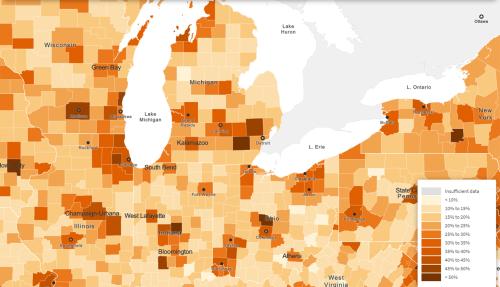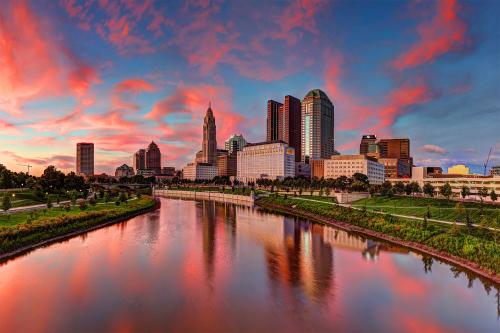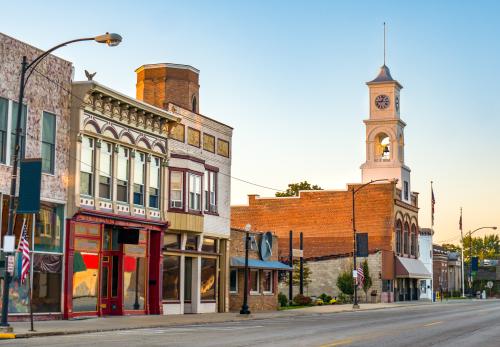President Trump’s anti-immigrant rhetoric played well to many in Rust Belt states like Michigan, Wisconsin, and Pennsylvania, helping knock down the Democrats’ “Blue Wall” and providing the necessary electoral votes to win the 2016 election.
Yet while states with the nation’s largest immigrant populations—California, Texas, Florida, Arizona—are often perceived to be most affected by federal immigration policies, the Midwest has a lot at stake, and not necessarily in ways anticipated by the region’s voters.
Ours are communities that for years have hemorrhaged population to the Sun Belt and other parts of the country. But as an earlier post in this series demonstrates, legal immigrants have kept coming to the Midwest.
In most of the Rust Belt, immigrants are a major source—and in many communities the only source—of population and new business growth. According to a 2017 Chicago Council on Global Affairs report, from 2000 to 2015, non-native born populations in Midwest metro areas grew by 34 percent (more than 1 million people) and accounted for 37 percent of all Midwest communities’ population growth. In my home state of Michigan, immigrants constitute 6 percent of the state’s population, but account for 15 percent of our STEM workers, started more than 25 percent of all our high-tech firms over the past two decades, and are responsible for 75 percent of patents filed from Michigan’s world-class research universities.
In most of the Rust Belt, immigrants are a major source—and in many communities the only source—of population and new business growth.
The Trump administration is now seeking to curb both illegal and legal immigration in ways that are already hitting the region hard. ICE raids have shaken immigrant and ethnic communities throughout the Midwest. Large Arab-American and Muslim communities in Southeast Michigan and elsewhere have been touched by the administration’s travel ban. The moratorium on refugee resettlement is turning off an important source of community population growth in areas that offered refuge to Syrians and others fleeing war and persecution. Uncertainties over the future of H-1B and guest worker visas are affecting our nascent high-tech and large-scale agricultural industries, while reductions in international students coming to our leading universities, and international visitors to Great Lakes shores and Midwestern cities, are all having bottom-line effects here. Research I conducted at the Michigan Economic Center with colleagues from Global Detroit quantifies significant economic costs to the state of Michigan from these policies.
The loss of Dreamers would undercut the Midwest’s continuing efforts to transform itself into a more vibrant knowledge economy.
Now the “Dreamers,” people brought to the United States illegally as children, are getting caught in the administration’s anti-immigration crosshairs, with significant consequences for the Midwest. A 2017 study by the Center for American Progress (CAP) finds that ending the Deferred Action for Childhood Arrivals (DACA) program, which provides Dreamers with the opportunity to live and work in the United States lawfully, could remove about 700,000 workers from the American economy. Of those, nearly 50,000 live in Midwestern states stretching from Iowa to Ohio. And of the roughly $41 billion CAP estimates that the United States economy would lose annually from removing DACA recipients, about $2.8 billion in economic activity would be drained from Rust Belt states. Relying as it does on immigrants for STEM talent, new business formation, and population growth generally, the loss of Dreamers would undercut the Midwest’s continuing efforts to transform itself into a more vibrant knowledge economy.

Losing our Dreamers will make it that much harder to remake the American Dream in once-thriving Rust Belt communities.
By Amazon’s telling, the company left Detroit, Grand Rapids, Milwaukee, Cleveland, Dayton, and most other Rust Belt communities off its finalist list for HQ2 in large part because of concerns over talent. This sends a strong signal that the revival of economies across the Rust Belt depends on growing, attracting, and keeping individuals who can drive innovation and new business and job growth in emerging sectors like clean energy, water, information technology, new mobility, food systems, and health care to replace the millions of jobs we have lost in traditional manufacturing industries. These great industries were built by migrants and immigrants flocking here from around the country and world for jobs in our factories, mills, and machine shops. Our region’s economic revival will again rely on its immigrants, including tens of thousands protected by DACA. Losing our Dreamers will make it that much harder to remake the American Dream in once-thriving Rust Belt communities.
Lucas Arbulu provided valuable research assistance for this post.







Commentary
Losing Dreamers would be a loss for Heartland economy
January 31, 2018